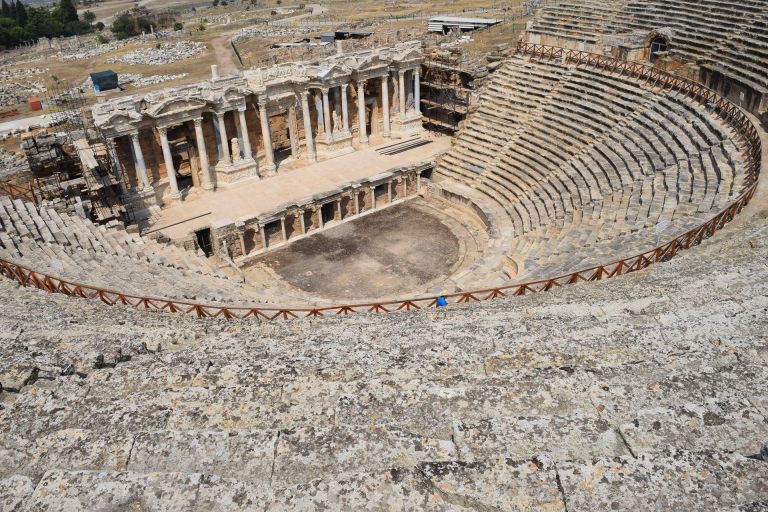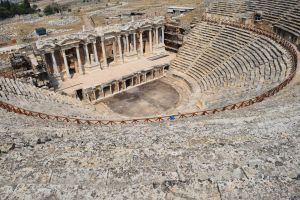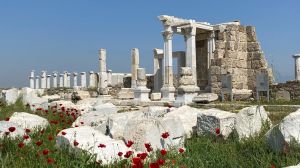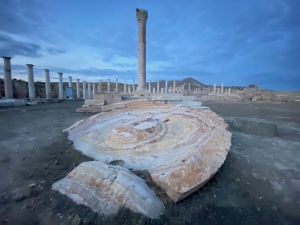The ancient city of Hierapolis
The ancient city of Hierapolis
The ancient city of Hierapolis, It is an archaeological treasure located in the Denizli province of Turkey and has been home to various civilizations throughout history. They're from M. Oh, my God. Dating back to the 2nd century, this ancient city has been influenced by many civilizations, from the Phrygians to the Romans. This ancient city, dating back hundreds of years, has been influenced by many civilizations, from the Phrygians to the Romans. In ancient times, the city was important as a religious center, especially dedicated to the cult of Kibele. Hierapolis includes an impressive ancient theater, necropolises, baths, temples, and a number of important structures such as Cleopatra's Pool. In addition, the region, which is also a UNESCO World Heritage Site, is a great place to visit for history and archaeology enthusiasts. In addition, Pamukkale is also famous for its natural beauty, being home to travertine terraces. The ancient city of Hierapolis combines history, culture, and natural beauty to offer visitors a unique experience.
Where is the ancient city of Hierapolis?
Where is the ancient city of Hierapolis? The Ancient City of Hierapolis is located in the Pamukkale district of Denizli Province, Turkey. It is located about 17 kilometers north of the seaside city center, quite close to the famous travertine terraces of Pamukkale. This ancient city is easily accessible from the center of the Sea City. The Ancient City of Hierapolis is famous for its historical and archaeological importance and is one of the tourist attractions of Pamukkale.
How to Get to the Ancient City of Hierapolis
How do you get to the ancient city of Hierapolis? The ancient city of Hierapolis The city is located in the Denizli province of Turkey. There are private vehicles, municipal buses, and bicycle options to reach Hierapolis from the maritime city center.
- By special vehicle: You can use a private vehicle to get to Hierapolis from the maritime city center. First, you'll need to enter Pamukkale Road from downtown Denizli. After a journey of about 20 minutes, you can reach the Ancient City. It will be useful to follow the signs marked for the Ancient City along the way.
- Public transportation : Those who want to go to Hierapolis by public transportation must take the minibuses that leave from the Sea Highway. These vans reach Old Town in about 25 minutes. You can use public transportation or taxis to get to the Maritime Motorway.
- Special tours of the area are also available and these tours can be a suitable option for those who want to visit the Ancient City of Hierapolis. These tours usually depart from the center of Denizli and offer the opportunity to explore the Ancient City accompanied by a guide. You can find out the details of the tours from the local tourism agencies or hotels.
Entrance fee to the ancient city of Hierapolis
Entrance fee to the ancient city of Hierapolis The entrance fee to the Ancient City of Hierapolis and the travertines in Pamukkale is 700 Turkish liras, typical for 2023. However, admission is free for museum card holders. This entrance fee allows you to explore the entire area of Pamukkale, visit the Ancient City of Hierapolis, and see the Ancient Pool.
Pamukkale Hierapolis Ancient city activities to do
Pamukkale Hierapolis Ancient City activities to do, The ancient city of Pamukkale Hierapolis has many interesting activities and sights for visitors. Here are some activities you can do in this ancient city:
- The Ancient Theatre: Discover the ancient theater, the most impressive structure in Hierapolis. This theater has a fascinating view and brings history to life for visitors.
- The necropolises: The necropolises around Hierapolis contain many tomb structures that reflect different religious beliefs. Take the time to explore these tombs and historic tombstones.
- The Pool of Cleopatra: This pool, dating back to ancient Rome, is located in thermal waters and offers visitors a unique swimming experience. You can enjoy the thermal water here, where Cleopatra is believed to have swum.
- The Great Bath: The Great Bath of Hierapolis contains the remains of ancient Roman baths. You can explore this area to discover the bathing culture of ancient times.
- The forbidden word: The Karahayit area next to Pamukkale is famous for its thermal hotels and spa facilities. Here you can enjoy the thermal waters and relax.
- A tour of the ancient city: A walk in the ancient city of Hierapolis is a wonderful opportunity to see historical ruins and monuments up close. Explore the remains of the Roman era and feel the atmosphere of the ancient city.
- The nature walks : The surroundings of Pamukkale offer a perfect setting for magnificent nature walks. Starting from Hierapolis, you can follow hiking routes to discover natural beauties.
- The photo shoot: The unique natural and historical beauty of Pamukkale and Hierapolis offers a great opportunity for photographers. The magnificent traverten terraces and ancient buildings provide the perfect backdrops to capture unforgettable memories.
The Theater of the Ancient City of Hierapolis
The theater of the ancient city of Hierapolis The Ancient Theater of Hierapolis is a large structure leaning on a hillside in the style of a Greek theater and has a fully preserved 91-meter façade. Built by M. The S. It was begun in 62 AD, but its completion was not completed until the reign of Severus in M. The S. He found the year 206. There are 50 rows in the seating section of the theater, called the cavea, and these rows are divided into 7 sections by 8 stairs. The area called Diozoma, right in the middle of the Cavea, can be accessed from both sides by tunnelled passages (vomitory). In the middle of the cavea is the royal chamber, and the front wall of the stage surrounding this chamber has five doors and six niches. In front of these niches are 10 columns. The tops of these marble columns are decorated with decorative motifs in the shape of oyster shells. Behind the stage, there's a row of three columns stacked on top of each other. The lower rows of columns rise on an octagonal base and are seamless.
Hierapolis Antik City Maritime, Theater reliefs were made by different masters in different periods. Especially in mythological scenes, it is possible to see the influences of Hellenistic period sculptural art. In these reliefs, along with crowded and lively figures, the influences of the Bergama school of art are also seen. In terms of the decoration of the stage building with reliefs, the Ancient Theater of Hierapolis is similar to other large theaters, especially the theaters of Perge, Side and Nyssa.
In addition, the necropolises around Hierapolis gained great importance after the city was called the "Holy City". These necropolises are home to burial structures that reflect different religious beliefs. According to the magnificence of the tombs, they can be classified as wealthy and public tombs. These necropolises extend north and south of the city's main street and contain more than 2,000 tombs. Reflecting the religious and cultural richness of Hierapolis, these necropolises are an important area of discovery for history and archaeology enthusiasts.
The story of the Antik City of Hierapolis is known as an important archaeological site with a deep-rooted history and culture located in the Denizli province of Turkey. This ancient city was built during the reign of the Kingdom of Pergamum by M. Oh, my God. It was founded at the beginning of the 2nd century and showed a great development, especially during the Hellenistic and Roman periods. It was founded at the beginning of the 20th century and experienced great development, especially during the Hellenistic and Roman periods. The city was used as a religious center dedicated to the mother goddess Cybele during the Phrygian period, but during the Greek colonization this temple was assimilated into Greek mythology. Hierapolis was also of great importance during the post-Roman Byzantine period and became a center of Christianity.
Information about the ancient city of Hierapolis
The history of the ancient city of Hierapolis, Archaeological excavations carried out in 2016 revealed important evidence that the ancient city of Hierapolis had its roots in the Iron Age. These excavations took the history of this ancient city further back, and traces of an Iron Age settlement were discovered here. But the history of Hierapolis is not limited to the Iron Age. The ancient city of Hierapolis hosted a religious center dedicated to Kibele, the mother goddess of Anatolia, during the time of Frigler. Initially, this temple was used by the local communities living in the valley of Lykos (Churuxu), but over time it became the center of Hierapolis, and this religious center became one of the most important structures of the city.
An important turning point in the history of Hierapolis was when the Greek colonization took place. When the Greek colonists founded the city on the pre-existing settlement, the ancient cult of Cybele was slowly assimilated into Greek mythology. Especially during this period, it was believed that this area had a connection to the underworld due to the poisonous gases coming out of a cave. Through the process of assimilation, the temple was associated with Hades (Pluton) and Persephone instead of Cybele and was named "Plutonium".
Although the exact date of the founding of Hierapolis is not known with certainty, it was built during the period of the Kingdom of Pergamon II. M by Eumenes. Oh, my God. It is known to have been founded in the early 2nd century. It is known to have been founded in the early 20th century. The name of the city comes from Hiera, queen of the Amazons, wife of the mythological founder of Bergama, Telephos. Hierapolis maintained its original texture by adhering to the principles of Hellenistic urbanization until the great earthquake during the reign of the Roman Emperor Nero. However, after the earthquakes, the city was completely rebuilt and took on the appearance of a typical Roman city.
Hierapolis was also of great importance during the post-Roman Byzantine period. From the 4th century AD, it became the center of Christianity, especially because one of Jesus' apostles, Philip, was killed here. From the 11th century onward, it became the center of Christianity, especially because Philip, one of Jesus' apostles, was killed here. The city served as the center of the bishopric during the Byzantine period. Today the Ancient City of Hierapolis has great wealth both historically and culturally and was included in the UNESCO World Heritage List in 1988.






Değerlendirmeler